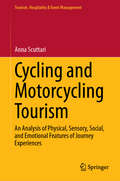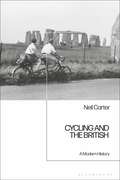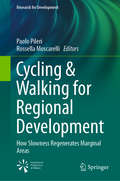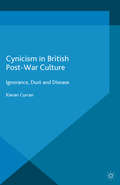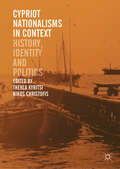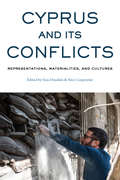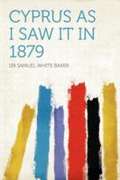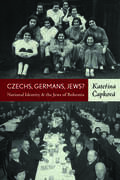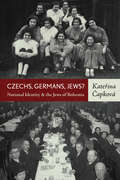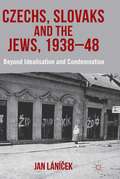- Table View
- List View
Cycles of Poverty and Crime in America's Inner Cities
by Lewis D. SolomonDespite the best hopes of the past half century, black urban pathologies persist in America. The inner cities remain concentrations of the uneducated, unemployed, underemployed, and unemployable. Many fail to stay in school and others choose lives of drugs, violence, and crime. Most do not marry, leading to single-parent households and children without a father figure. The cycle repeats itself generation after generation.It is easy to argue that nothing works, given the policy failures of the past. For Lewis D. Solomon, fatalism is not acceptable. A complex and interrelated web of issues plague inner-city black males: joblessness; the failure of public education; crime, mass incarceration, and drugs; the collapse of married, two-parent families; and negative cultural messages. Rather than abandon the black urban underclass, Solomon presents strategies and programs to rebuild lives and revitalize America's inner cities. These approaches are neither government oriented nor dependent on federal intervention, and they are not futuristic.Focusing on rehabilitative efforts, Solomon describes workforce development, prisoner reentry, and the role of nonprofit organizations. Solomon's strategies focus on the need to improve the quality of America's workforce through building human capital at the socioeconomic bottom. The goal is to enable more people to fend for themselves, thereby weaning them from dependency on public sector handouts. Solomon shows a path forward for inner-city black males.
Cyclical Time & Ismaili Gnosis
by Henry CorbinThe volume Cyclical Time and Ismaili Gnosis brings together in English translation three of Henry Corbin’s richest and most complex studies, originally presented at the Eranos conferences of 1951 and 1954 and another conference in 1956. Each of these three relatively early studies is built around a complex, highly creative ‘comparison’ of the phenomenological correspondences between texts (often highly fragmentary) from a vast range of spiritual traditions from late Antiquity (including Manichaenism and the sects of Sassanid Iran) – all ‘gnostic’ in the root Greek sense of that term favoured by Corbin, though not in the narrower historical sense used by most contemporary scholars – and comparable spiritual themes in an equally wide range of Islamic texts eventually preserved in the later Ismaili Shi‘i tradition.
Cyclical Time & Ismaili Gnosis
by Henry CorbinThe volume Cyclical Time and Ismaili Gnosis brings together in English translation three of Henry Corbin’s richest and most complex studies, originally presented at the Eranos conferences of 1951 and 1954 and another conference in 1956. Each of these three relatively early studies is built around a complex, highly creative ‘comparison’ of the phenomenological correspondences between texts (often highly fragmentary) from a vast range of spiritual traditions from late Antiquity (including Manichaenism and the sects of Sassanid Iran) – all ‘gnostic’ in the root Greek sense of that term favoured by Corbin, though not in the narrower historical sense used by most contemporary scholars – and comparable spiritual themes in an equally wide range of Islamic texts eventually preserved in the later Ismaili Shi‘i tradition.
Cycling: A Sociology of Vélomobility (Changing Mobilities)
by Peter CoxCycling: A Sociology of Vélomobility explores cycling as a sociological phenomenon. Drawing on extensive ethnographic fieldwork, it considers the interaction of materials, competencies and meanings that comprise a variety of cycling practices. What might appear at first to be self-evident actions are shown to be constructed through the interplay of numerous social and political forces. Using a theoretical framework from mobilities studies, its central themes respond to the question of what it is about cycling that provokes so much interest and passion, both positive and negative. Individual chapters consider how cycling has appeared as theme and illustration in social theory, as well as the legacies of these theorizations. The book expands on the image of cycling practices as the product of an assemblage of technology, rider and environment. Riding spaces as material technologies are found to be as important as the machinery of the cycle, and a distinction is made between routes and rides to help interpret aspects of journey-making. Ideas of both affordance and script are used to explore how elements interact in performance to create sensory and experiential scapes. Consideration is also given to the changing identities of cycling practices in historical and geographical perspective. The book adds to existing research by extending the theorization of cycling mobilities. It engages with both current and past debates on the place of cycling in mobility systems and the problems of researching, analyzing and communicating ephemeral mobile experiences.
Cycling: A Sociology of Vélomobility (Changing Mobilities)
by Peter CoxCycling: A Sociology of Vélomobility explores cycling as a sociological phenomenon. Drawing on extensive ethnographic fieldwork, it considers the interaction of materials, competencies and meanings that comprise a variety of cycling practices. What might appear at first to be self-evident actions are shown to be constructed through the interplay of numerous social and political forces. Using a theoretical framework from mobilities studies, its central themes respond to the question of what it is about cycling that provokes so much interest and passion, both positive and negative. Individual chapters consider how cycling has appeared as theme and illustration in social theory, as well as the legacies of these theorizations. The book expands on the image of cycling practices as the product of an assemblage of technology, rider and environment. Riding spaces as material technologies are found to be as important as the machinery of the cycle, and a distinction is made between routes and rides to help interpret aspects of journey-making. Ideas of both affordance and script are used to explore how elements interact in performance to create sensory and experiential scapes. Consideration is also given to the changing identities of cycling practices in historical and geographical perspective. The book adds to existing research by extending the theorization of cycling mobilities. It engages with both current and past debates on the place of cycling in mobility systems and the problems of researching, analyzing and communicating ephemeral mobile experiences.
Cycling and Motorcycling Tourism: An Analysis of Physical, Sensory, Social, and Emotional Features of Journey Experiences (Tourism, Hospitality & Event Management)
by Anna ScuttariThis book explores the understanding, description, and measurement of the physical, sensory, social, and emotional features of motorcycle and bicycle journey experiences in tourism. Novel insights are presented from an original case study of these forms of tourism in the Sella Pass, a panoramic road close to the Dolomites UNESCO World Heritage Site. A comprehensive mixed-methods strategy was employed for this research, with concurrent use of quantitative and qualitative methods including documentation and secondary data analysis, mobile video ethnography, and emotion measurement. The aim was to create a holistic knowledge of the features of journey experiences and a new definition of the mobility space as a perceptual space. The book is significant in that it is among the first studies to explore the concept of journey experiences and to develop an interdisciplinary theoretical foundation of mobility spaces. It offers a comprehensive understanding and a benchmarking of the features of motorcycling and cycling journey experiences, a deeper market knowledge on motorcycling and cycling tourists, and a set of tools, techniques, and recommendations for future research on tourist experiences.
Cycling and Society
by Peter Cox Dave Horton Paul RosenHow can the social sciences help us to understand the past, present and potential futures of cycling? This timely international and interdisciplinary collection addresses this question, discussing shifts in cycling practices and attitudes, and opening up important critical spaces for thinking about the prospects for cycling. The book brings together, for the first time, analyses of cycling from a wide range of disciplinary backgrounds, including history, sociology, geography, planning, engineering and technology. The book redresses the past neglect of cycling as a topic for sustained analysis by treating it as a varied and complex practice which matters greatly to contemporary social, cultural and political theory and action. Cycling and Society demonstrates the incredible diversity of contemporary cycling, both within and across cultures. With cycling increasingly promoted as a solution to numerous social problems across a wide range of policy areas in car-dominated societies, this book helps to open up a new field of cycling studies.
Cycling and Society
by Peter Cox Dave Horton Paul RosenHow can the social sciences help us to understand the past, present and potential futures of cycling? This timely international and interdisciplinary collection addresses this question, discussing shifts in cycling practices and attitudes, and opening up important critical spaces for thinking about the prospects for cycling. The book brings together, for the first time, analyses of cycling from a wide range of disciplinary backgrounds, including history, sociology, geography, planning, engineering and technology. The book redresses the past neglect of cycling as a topic for sustained analysis by treating it as a varied and complex practice which matters greatly to contemporary social, cultural and political theory and action. Cycling and Society demonstrates the incredible diversity of contemporary cycling, both within and across cultures. With cycling increasingly promoted as a solution to numerous social problems across a wide range of policy areas in car-dominated societies, this book helps to open up a new field of cycling studies.
Cycling and the British: A Modern History
by Neil CarterCycling is currently enjoying a boom in popularity. What are the reasons behind this phenomenon? How have perceptions and the popularity of cycling shifted? This book charts the historical development of cycling both as a leisure and sporting activity since the 19th century and explores the wider political and cultural context in which cycling in Britain emerged. In particular, it examines cycling's relationship with environmental politics and its place in popular culture. Neil Carter successfully traverses several historical sub-disciplines, including the history of transport, leisure, sport, medicine and politics, employing the analytical tools of class, gender, political culture, the role of the state and commercialism to demonstrate how British identity has shaped and been shaped by cycling. At a time when it has become part of debates over transport and health, Cycling and the British: A Modern History provides a timely and clear analysis of the changes and continuities in attitudes towards cycling.
Cycling and the British: A Modern History
by Neil CarterCycling is currently enjoying a boom in popularity. What are the reasons behind this phenomenon? How have perceptions and the popularity of cycling shifted? This book charts the historical development of cycling both as a leisure and sporting activity since the 19th century and explores the wider political and cultural context in which cycling in Britain emerged. In particular, it examines cycling's relationship with environmental politics and its place in popular culture. Neil Carter successfully traverses several historical sub-disciplines, including the history of transport, leisure, sport, medicine and politics, employing the analytical tools of class, gender, political culture, the role of the state and commercialism to demonstrate how British identity has shaped and been shaped by cycling. At a time when it has become part of debates over transport and health, Cycling and the British: A Modern History provides a timely and clear analysis of the changes and continuities in attitudes towards cycling.
Cycling Futures: From Research into Practice
by Regine Gerike John ParkinPointing the way to the future of research and development in relation to cycling as a mode of transport, this book investigates some of the significant recent developments in the technology, provision for, and take up of cycling in various parts of the world. Tensions at the heart of the nature of cycling remain: on the one hand cycling is frequently viewed as being a risky activity, while on the other hand it is seen as being a way of allowing populations to live healthier lives. Reviewing this dichotomy, the authors in this book consider the ways that cycling is planned and promoted. This is done partly in relation to these issues of risk and health, but also from the broader perspective of behavioural response to the changing nature of cycling. A section on methodologies is also included which outlines the current state-of-the art and points a way to future research.
Cycling Futures: From Research into Practice
by Regine Gerike John ParkinPointing the way to the future of research and development in relation to cycling as a mode of transport, this book investigates some of the significant recent developments in the technology, provision for, and take up of cycling in various parts of the world. Tensions at the heart of the nature of cycling remain: on the one hand cycling is frequently viewed as being a risky activity, while on the other hand it is seen as being a way of allowing populations to live healthier lives. Reviewing this dichotomy, the authors in this book consider the ways that cycling is planned and promoted. This is done partly in relation to these issues of risk and health, but also from the broader perspective of behavioural response to the changing nature of cycling. A section on methodologies is also included which outlines the current state-of-the art and points a way to future research.
Cycling & Walking for Regional Development: How Slowness Regenerates Marginal Areas (Research for Development)
by Paolo Pileri Rossella MoscarelliThis book investigates why and how cycle and walking paths can help to promote the regeneration of marginalized areas facing depopulation and economic decline. In addition, it offers a broad overview of recent scientific research into slow tourism and marginality/spatial inequality and explores the linkages between these topics. Key issues are addressed by experts from various disciplinary backgrounds, and potential measures are proposed for the integration of slow tourism into strategies for regional development. Particular attention is devoted to the VENTO project, which involves the creation of a 700-km-long cycle route from Venice to Turin that passes through various rural and marginalized areas of northern Italy. The goal, research process, design, and early lessons from this important project are all discussed in detail. Moreover, the book describes policies and strategies that have successfully been used to enhance the slow tourism infrastructure in other European countries. Given its scope, the book will appeal to researchers, professionals, and students interested in e.g. policymaking, tourism planning, regional development, and landscape and urban planning.
Cyclonic Disasters and Resilience: An Empirical Study on South Asian Coastal Regions (Advances in Geographical and Environmental Sciences)
by Ashutosh Mohanty Anupama Dubey R. B. SinghThe Bay of Bengal is prone to tropical cyclones and storm surges as a result of its location, and many of the mostly poor people living along the coastal regions of South Asia lose their lives almost every year. These disasters have been particularly devastating and have caused serious damage. During the past five decades, the low-lying coastal and offshore islands have experienced a tragic history of 50 severe cyclones and storm surges, with more than one million victims dead or missing. People accepted and waited for the next disaster as they had no alternatives. Members of the poor families who survived the disasters experienced hard times recovering from damage and the loss of their loved ones. After disasters, epidemic diseases arise in the affected areas. Many of the people in distress are also deprived of public services. Providing all sorts of assistance and emergency health preparedness are most essential to overcome such a situation. The causes of these huge casualties have been mainly: (1) the high population density of costal settlements, (2) inadequate cyclone shelters in the disaster risk areas, (3) lack of awareness of the disaster risk by the vulnerable population, (4) deterministic attitudes of people who accept disasters as “fate”, (5) houses that are weakly constructed and (6) underdeveloped central awareness programmes and weather forecast systems. This book is based on an empirical study presenting a timeline analysis of major cyclones and their impacts and consequent losses through the super-cyclones in the disaster-prone coastal regions of India, Sri Lanka and Bangladesh. This study also investigates resilience mechanisms based on early warning systems, technology applications including GIS and remote sensing, best practices, success stories and case studies that can be used for effective cyclone management and development of a resilience mechanism among coastal communities.
Cynical Theories: How Universities Made Everything about Race, Gender, and Identity - And Why this Harms Everybody
by James Lindsay Helen Pluckrose‘Exposes the surprisingly shallow intellectual roots of the movements that appear to be engulfing our culture’ Steven Pinker Have you heard that language is violence and that science is sexist? Or been told that being obese is healthy, that there is no such thing as biological sex, or that only white people can be racist? Are you confused by these ideas, and do you wonder how they have managed so quickly to challenge the very logic of Western society? Helen Pluckrose and James Lindsay document the evolution of the dogma behind these ideas, from its origins in French postmodernism to its refinement within activist academic fields. Today this dogma is recognisable as much by its effects, such as cancel culture and social-media pile-ons, as by its assertions, which are all too often taken as read: knowledge is a social construct; science and reason are tools of oppression; all human interactions are sites of oppressive power play; and language is dangerous. As they warn, the unchecked proliferation of these beliefs present a threat to liberal democracy itself. While acknowledging the need to challenge the complacency of those who think a just society has been fully achieved, Pluckrose and Lindsay break down how often-radical activist scholarship does far more harm than good, not least to those marginalized communities it claims to champion. Only through a proper understanding of the evolution of these ideas, they conclude, can those who value science, reason and consistently liberal ethics successfully challenge this harmful and authoritarian orthodoxy.
Cynicism in British Post-War Culture: Ignorance, Dust and Disease
by K. CurranThis book is the first academic text to examine cynicism as a driving force in the context of post-war British culture. It maps a sensibility that transcends divisions between high and low culture, and encompasses figures such as Philip Larkin, John Lennon and Stephen Patrick Morrissey.
Cypriot Nationalisms in Context: History, Identity and Politics
by Thekla Kyritsi Nikos ChristofisThis book explores the different perspectives and historical moments of nationalism in Cyprus. It does this by looking at nationalism as a form of identity, as a form of ideology, and as a form of politics. The fifteen contributors to this book are scholars of different scientific backgrounds and present Cypriot nationalisms from an interdisciplinary framework, including approaches such as history, political science, psychology, and gender studies. The chapters take a historical approach to nationalism and argue that the world of nations, ethnic identity, and national ideology are neither eternal, nor ahistorical nor primordial, but are rather socially constructed and function within particular historical and social contexts. As a land that was, and still is, marked by opposed nationalisms – that is, Greek and Turkish – Cyprus constitutes a fertile ground for examining the history, the dynamics, and the dialectics of nationalism.
Cyprus and its Conflicts: Representations, Materialities, and Cultures
by Vaia Doudaki and Nico CarpentierThe Mediterranean island of Cyprus is the site of enduring political, military, and economic conflict. This interdisciplinary collection takes Cyprus as a geographical, cultural and political point of reference for understanding how conflict is mediated, represented, reconstructed, experienced, and transformed. Through methodologically diverse case studies of a wide range of topics—including public art, urban spaces, and print, broadcast and digital media—it assembles an impressively multifaceted perspective, one that provides broad insights into the complex interplay of culture, conflict, and identity.
Cyprus and its Places of Desire: Cultures of Displacement among Greek and Turkish Cypriot Refugees (International Library of Ethnicity, Identity and Culture #Vol. 1)
by Lisa DikomitisFor almost four decades, the island of Cyprus has been home to two separate refugee communities. Charting the displacement experience of the Greek Cypriot community in the south, and that of the Turkish Cypriot community in the north, this book provides a moving and detailed ethnography of the refugee experience in Cyprus. In her groundbreaking study, made possible by the opening of the dividing Green Line during fieldwork, Lisa Dikomitis demonstrates how both groups are linked by their histories of displacement to a single 'place of desire', a small mountainous village located in the north of Cyprus. Through a focus on the nature of the attachment to this particular village, and how this attachment has been shaped by questions of home, identity, justice and suffering, the author identifies the specific social and cultural meanings that citizenship and belonging have come to have for both communities.The original name of the village is Larnakas tis Lapithou and for its former Greek Cypriot inhabitants, who fled during the Turkish invasion of 1974 and are scattered across the south ofCyprus, it will always remain so. But the village has changed drastically. It was renamed after 1974 to Kozan by the Turkish Cypriot authorities, and became home to Turkish Cypriot refugees from the south. Throughout this work, Lisa Dikomitis emphasizes the importance of place as a constructed network of social relationships. For Greek Cypriots the desire is to return to the village and recreate the network of relationships that was shattered by the war. For Turkish Cypriots the desire is to remain in the village and maintain the network of relationships that was constructed since the war. And for both this process is a question of justice and recognition of their suffering. The opening of the checkpoints on the border in 2003 provided a unique opportunity to conduct long-term fieldwork among Turkish Cypriots, something never done before by a Greek Cypriot anthropologist. Using anthropological methods, Dikomitis observed and participated in daily experiences over this period of dramatic change in the lives of these Cypriot refugees - recording a collection of multi-sited narratives, hopes and memories along the way.
Cyprus, as I Saw It in 1879
by Sir Samuel White BakerCyprus was placed under British control in 1878 as a result of the Cyprus Convention, which granted control of the island to Britain in return for British support of the Ottoman Empire in the Russian-Turkish War. Little was known about the country at the time and this work is the result of a visit by Baker, an English explorer and author, in 1879.
Czech Women Philosophers and Scientists (SpringerBriefs in History of Science and Technology)
by Zdeňka Jastrzembská Dagmar Pichová Jan ZouharThis book examines the most important Czech women philosophers and scientists. It highlights the lives and achievements of a group that has often not received the recognition they deserve. Chapters provide a systematic description and critical evaluation of the impact these women had on the history of philosophy and science. After an opening chapter on the status of women philosophers and scientists in the period before 1820, the book explores the role women played in the 19th century rise of Czech culture (Czech National Revival). The following chapter then introduces the situation of Czech women philosophers and scientists in the 20th century. The authors base the material on analysis of key works and the characteristics of contemporary debates in which these women participated. The volume describes the complex conditions of women in Czech history in relation to the position of learned women in other European countries. The authors also emphasize their link tothe historical background. This encompassing coverage helps provide readers with a richer understanding of these important women and the period in which they lived. Academicians and the general public alike will also learn about the political and social limitations these women faced and the influence of historical conditions on their work.
Czechoslovakia and Eastern Europe in the Era of Normalisation, 1969–1989
by Kevin McDermott Matthew StibbeThis edited collection represents the first comprehensive volume in English on the crucial, but under-explored, late period in the history of East European communism. Focusing on developments in Czechoslovakia from the crushing of the Prague Spring in August 1968 to the ‘Velvet Revolution’ of November 1989, the book examines a broad range of political, social and cultural issues, while also analysing external perceptions and relations. It explores the concept of ‘normalisation’ in historical context and brings together British, American, Czech and Slovak experts, each with their own archival research and particular interpretations. Overall, the anthology aims to assess the means by which the Prague Spring reforms were repealed and how Czechoslovakia was returned to a ‘normal’ communist state in line with Soviet orthodoxy. Key themes include the Communist Party and ideology; State Security; Slovak developments; ‘auto-normalisation’; women and gender; cultural and intellectual currents; everyday life and popular opinion; and Czechoslovakia’s political and cultural relationship with the USSR, the GDR, Poland and Yugoslavia. The volume sheds light on the process of decay of the Czechoslovak communist regime and the reasons for its ultimate collapse in 1989.
Czechs, Germans, Jews?: National Identity and the Jews of Bohemia
by Kateřina ČapkováThe phenomenon of national identities, always a key issue in the modern history of Bohemian Jewry, was particularly complex because of the marginal differences that existed between the available choices. Considerable overlap was evident in the programs of the various national movements and it was possible to change one’s national identity or even to opt for more than one such identity without necessarily experiencing any far-reaching consequences in everyday life. Based on many hitherto unknown archival sources from the Czech Republic, Israel and Austria, the author’s research reveals the inner dynamic of each of the national movements and maps out the three most important constructions of national identity within Bohemian Jewry – the German-Jewish, the Czech-Jewish and the Zionist. This book provides a needed framework for understanding the rich history of German- and Czech-Jewish politics and culture in Bohemia and is a notable contribution to the historiography of Bohemian, Czechoslovak and central European Jewry.
Czechs, Germans, Jews?: National Identity and the Jews of Bohemia
by Kateřina ČapkováThe phenomenon of national identities, always a key issue in the modern history of Bohemian Jewry, was particularly complex because of the marginal differences that existed between the available choices. Considerable overlap was evident in the programs of the various national movements and it was possible to change one’s national identity or even to opt for more than one such identity without necessarily experiencing any far-reaching consequences in everyday life. Based on many hitherto unknown archival sources from the Czech Republic, Israel and Austria, the author’s research reveals the inner dynamic of each of the national movements and maps out the three most important constructions of national identity within Bohemian Jewry – the German-Jewish, the Czech-Jewish and the Zionist. This book provides a needed framework for understanding the rich history of German- and Czech-Jewish politics and culture in Bohemia and is a notable contribution to the historiography of Bohemian, Czechoslovak and central European Jewry.
Czechs, Slovaks and the Jews, 1938-48: Beyond Idealisation and Condemnation
by J. Lánicek Jan Lání?ekCovering the period between the Munich Agreement and the Communist Coup in February 1948, this groundbreaking work offers a novel, provocative analysis of the political activities and plans of the Czechoslovak exiles during and after the war years, and of the implementation of the plans in liberated Czechoslovakia after 1945.



